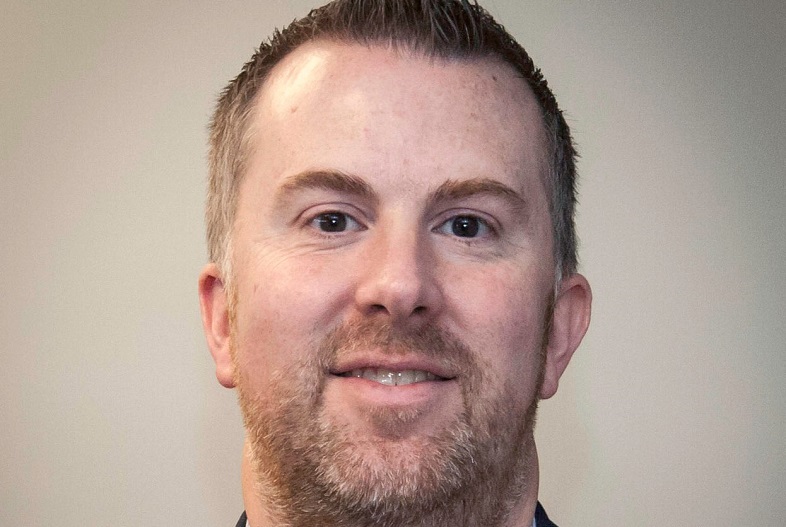
Ross Named Broadcast & Media Coordinator
By
Geoff Kimmerly
MHSAA.com senior editor
February 19, 2021
Jon Ross, bringing vast experience in video production and after working both as television media and in media relations, has been added to the Michigan High School Athletic Association staff as broadcast & media coordinator, a role in which he’ll focus primarily on video production, day-to-day efforts by the MHSAA Network and other communications duties.
 Ross, who began at the MHSAA in late December, is taking on many of the duties formerly handled by John Johnson, who retired Dec. 18 after 33 years as communications director and then director of broadcast properties.
Ross, who began at the MHSAA in late December, is taking on many of the duties formerly handled by John Johnson, who retired Dec. 18 after 33 years as communications director and then director of broadcast properties.
Ross’s variety of past experiences already have served the MHSAA well during his first weeks in his new position. In addition to generating “This Week in High School Sports” played on more than 100 radio stations statewide and the “MHSAA Minute” produced weekly with State Champs! Sports Network, Ross stepped in almost immediately to direct MHSAA Network broadcasts of Fall playoffs that were restarted in January and worked with FOX Sports Detroit for its production of the 8 and 11-Player Football Finals during Jan. 16 and Jan. 22-23, respectively.
“Jon has been a wonderful addition to our team,” MHSAA Executive Director Mark Uyl said. “His background in video production will serve the MHSAA well, and he’s done an outstanding job jumping in mid-stream with our Final fall tournaments being completed in January followed by an immediate move to winter events. Jon is a terrific addition to the MHSAA team.”
Ross began his media career in June 1999 at the first of three television sports department stops, a string that concluded with his tenure as a reporter and anchor from 2002-05 for WILX in Lansing.
Most recently, Ross served from Feb. 2018 until this past December as a communications representative and senior editor for the Michigan Office of Highway Safety Planning, for which he helped manage development of statewide campaigns including “Click It Or Ticket” and “Drive Sober, Get Pulled Over.” In addition to content creation, Ross worked in media relations including as occasional spokesperson for the OHSP, along with managing budgets and execution of federally-funded campaigns and serving as chairperson of the 2019 Michigan Traffic Safety Summit which drew nearly 500 attendees.
At the MHSAA, Ross’s responsibilities also will include providing content for the Association’s websites including the fan-focused Second Half, managing MHSAA.tv and eventually media credentialing and other on-site communications functions at MHSAA events.
“My time working in sports never seemed like work, and I’m excited for the opportunity to be part of what the MHSAA is building as it continues to expand coverage especially with video and other digital ventures,” Ross said. “I’ve known John Johnson going back to my time in the media, and I can appreciate even more now the work he did in making the MHSAA a national leader in promoting school athletics. I hope my experiences will help us build on what he created as we continue to engage more with our schools and specifically athletes, coaches, officials and families to tell our story.”
Ross was born in Escanaba and is a 1995 graduate of Saginaw Heritage High School and 1999 graduate of Michigan State University, where he earned a bachelor’s degree in journalism with specialty in kinesiology.

Spring Preliminary Concussion Data Announced
June 28, 2016
By Geoff Kimmerly
Second Half editor
Similar to information gathered after the first two seasons of the 2015-16 school year, the Michigan High School Athletic Association has found through collection of preliminary data that fewer than one percent of its more than 100,000 spring student-athletes experienced potential concussions during the season that concluded early this month.
The MHSAA this school year requested for the first time that member schools report possible concussions by their student-athletes during both practice and competition. As expected, the overall percentage of spring student-athletes with potential concussions was lower than for both fall and winter – as many spring sports involve only limited contact. A first set of preliminary data announced in December showed only two percent of more than 100,000 high school fall athletes experienced concussions during that first season of 2015-16. Preliminary data released in May for the winter also showed two percent of that season’s more than 70,000 student-athletes had experienced potential concussions as well.
As it did for the fall and winter, the MHSAA again received data from more than 99 percent of its member high schools at the end of the spring season. The average number of possible spring concussions reported by member high schools through June 27, 2016, was 1.0 concussion per school – fewer than the averages per school reported for the fall (3.2) and winter (1.6) seasons. Just under 50 percent of reporting schools stated they had no concussions by athletes this spring.
However, six spring sports — including girls track & field — registered at least 20 possible concussions, and for the second consecutive season a girls sport reported the highest percentage. Following girls basketball in the winter, girls soccer revealed 53 percent of possible concussions reported this spring – despite only 12 percent of spring student-athletes participating in that sport. Softball, also with roughly 12 percent of spring student-athletes, followed with 19 percent of possible concussions reported. Boys lacrosse, with 11 percent of possible concussions, ranked third-highest overall and highest among boys sports this spring. Roughly five percent of spring student-athletes play boys lacrosse.
Girls soccer has produced 58 percent more potential concussions than boys soccer did during the fall, despite seven percent fewer student-athletes playing girls soccer. Boys lacrosse, meanwhile, had nearly three times as many possible concussions as girls lacrosse – with only 48 percent more participants.
Schools also are required to designate if potential concussions occurred during competition or practice and at which level – varsity, junior varsity or freshman – and this spring those designations provided additional compelling data. In girls lacrosse, 63 percent of possible concussions occurred at the varsity level, while softball saw its most at the junior varsity level and baseball saw as many at the varsity level as the junior varsity and freshman levels combined.
“The preliminary data we were able to collect this spring again shows, and especially with girls soccer, why we must work for solutions to limit head injuries in all sports and not focus solely on sports that are most publicized,” MHSAA Executive Director John E. “Jack” Roberts said. “As we now move toward solidifying our research from this school year, we expect to learn even more about which factors contribute most to the sustaining of concussions at the high school level, and what our administrators, coaches, rule-makers and others might be able to do to make our games even safer and healthier for our student-athletes.”
Data collected by the MHSAA remains preliminary, in part, because results noted include pending reports that have not been verified. After completion of these follow-up reports, the final number of concussions that actually occurred this past season and during the fall and winter may be lower than the preliminary numbers being reported at this time.
The data analyzed to date is for high schools only, although middle schools also have the opportunity to report possible concussions. A full breakdown of the data including concussions by gender, sport, team level (varsity through junior high) and setting (practice or event) will be reported at the end of this summer.
The reporting of possible concussions is part of a three-pronged advance by the MHSAA in concussion care begun during the 2015-16 school year which is producing data related to the frequency and severity of head injuries. The MHSAA in fall 2015 launched the largest ever state high school association sideline concussion testing pilot program, with 62 schools taking part by using one of two screening tests designed to detect concussions. One of the objectives of the pilot was to increase awareness of concussions and improve sideline detection; and preliminary results have indicated that the average number of possible concussions reported by pilot schools exceeds the average reported by schools outside the pilot group.
Of 15 schools reporting the most possible concussions this spring, six are part of the MHSAA’s pilot sideline detection programs. Those programs – King-Devick Test and XLNTbrain Sport – utilize technology to provide on-site testing of athletes who have sustained possible concussions, with results of those examinations then compared against baseline tests taken by athletes previously. Schools participating in the pilot programs for the 2016-17 school year received training at the MHSAA office in East Lansing on June 16 and 17.
The MHSAA also is the first state association to provide all participants at every member high school and junior high/middle school with insurance intended to pay accident medical expense benefits – covering deductibles and co-pays left unpaid by other policies – resulting from head injuries sustained during school practices or competitions and at no cost to either schools or families. The program has produced additional data about the frequency and severity of head injuries. As of June 27, only 144 claims had been made on the insurance policy designed to assist in payment for concussion care. Fifty-one of the claims are for football, 39 are for basketball (girls and boys combined) and 14 are for boys soccer.
Schools report possible concussions online via the MHSAA Website. Reports are then examined by members of the MHSAA staff, who follow up with school administrators as those student-athletes continue to receive care and eventually return to play. Student privacy is protected.
Previously, the MHSAA also was among the first state associations to adopt a return-to-play protocol that keeps an athlete out of activity until at least the next day after a suspected concussion, and allows that athlete to return to play only after he or she has been cleared for activity by a doctor (M.D. or D.O.), physician’s assistant or nurse practitioner. The follow-up reports schools are providing the MHSAA reveal that the majority of students are being withheld from activity for a week or longer following the reported concussion. This will be discussed in more detail when the MHSAA releases a more comprehensive review that covers the entire school year.
The MHSAA is a private, not-for-profit corporation of voluntary membership by more than 1,400 public and private senior high schools and junior high/middle schools which exists to develop common rules for athletic eligibility and competition. No government funds or tax dollars support the MHSAA, which was the first such association nationally to not accept membership dues or tournament entry fees from schools. Member schools which enforce these rules are permitted to participate in MHSAA tournaments, which attract more than 1.4 million spectators each year.
-0-

